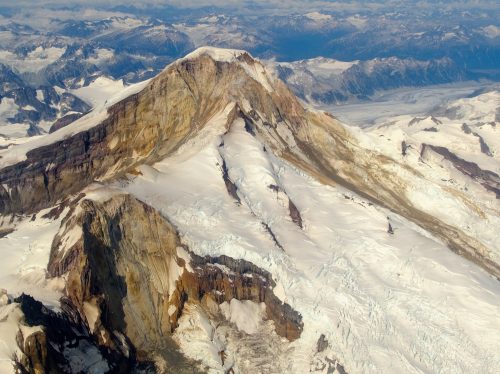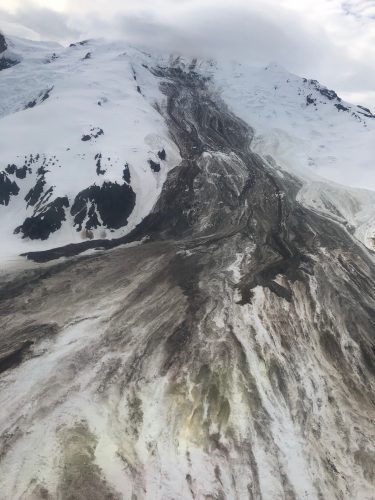Listening to avalanches half a state away
April 15, 2021
Ned Rozell
907-474-7468

High on the broken pyramid of Iliamna Volcano, rotten rock held in place by volcano-warmed ice sometimes loses its grip.
Several times over the years, rock-and-ice avalanches have blasted down Iliamna at 150 miles per hour. Left behind on the mountain’s face is a dirty, five-mile scar, in the same place as the last one.
Due to the location of the volcano — 60 miles across Cook Inlet from Ninilchik, Anchor Point and Homer — no one hears Iliamna’s avalanches. But after giant slides there in May 2016 and June 2019, scientific microphones captured the air-pressure disturbances all the way from Fairbanks, 375 miles away.
Scientists are using these recorded signals far from the volcano to better understand avalanches in steep, icy country.
Liam Toney is a graduate student at UAF’s Geophysical Institute who has become an authority on a slope of a volcanic mountain he has not yet visited.
At 10,015 feet, Iliamna is one of the tallest volcanoes in the Aleutian Arc. It has no historic eruptions, but the mountain’s hot spots belch sulfurous gases into the cold air. The blue-white, snow-capped volcano is visible on clear days to people living on the western Kenai Peninsula.

Avalanches have rumbled down the Red Glacier valley on Iliamna many times in the summer, including in 1960, 1978, 1980, 1983, 1994, 1997, 2000 and 2003, as well as in 2016 and 2019.
Scientists think big slides happen there so often because the glacier gains so much weight each year in snowfall that gravity takes over, with a big assist from the volcano’s heat.
In 2019, Toney was analyzing the Red Glacier avalanche from 2016. That summer, upon returning from a trip, he learned that instruments planted throughout Alaska had captured yet another avalanche, on the same eastern flank of the volcano.
 “When I came back from the field I began to look at the imagery and noticed how similar
it was,” Toney said. “That was the most wild thing.”
“When I came back from the field I began to look at the imagery and noticed how similar
it was,” Toney said. “That was the most wild thing.”He quickly modified his Ph.D. study to include the more recent avalanche down Iliamna’s side. The instruments Toney used included about 25 ground-motion-sensing seismometers buried in the ground around the volcano.
Toney also used the recordings of an infrasound array — a collection of microphones working together — installed in the woods north of UAF campus buildings, within skiing distance of his home.
Infrasound microphones capture sound waves that have frequencies too low for humans — but not some animals, including elephants — to hear. Scientists at the Geophysical Institute have installed infrasound arrays all over the world, including one in a 1,200-acre wooded area laced with trails on the Fairbanks campus.
Far-off nuclear explosions generate infrasound waves that travel around the planet. Researchers with the UAF group have for a long time shared their results with officials who monitor countries’ compliance with treaties.
In their listening, scientists have also found the microphones pick up other disturbances in the air, including the dance of the aurora borealis, far-off ocean surf during storms, and massive landslides.
Workers for the Alaska Volcano Observatory just installed infrasound microphones in the town of Whittier, in hopes they might record a potential landslide in Prince William Sound’s Barry Arm. Others are in place in Kenai, on the island of Adak, in the fishing town of Dillingham, and in a few other locations near volcanoes.

In comparing the two avalanches on Iliamna Volcano, Toney found they had almost the same runout length of about five miles, a distance he knows well from running 8K races during his undergraduate days.
Toney also found that the acoustic and seismic signals from the avalanches told him where the unseen slide was and in what direction it rumbled. That information might help researchers pinpoint massive events that happen in the wilds of Alaska and other places.
With warmer air shrinking glaciers in Alaska, scientists might look to infrasound and seismic signals for clues on when oversteep mountain slopes will fail.
“Climate change causes shifting landscapes,” Toney said. “That might cause more of these events.”
Since the late 1970s, the University of Alaska Fairbanks' Geophysical Institute has provided this column free in cooperation with the UAF research community. Ned Rozell is a science writer for the Geophysical Institute.


